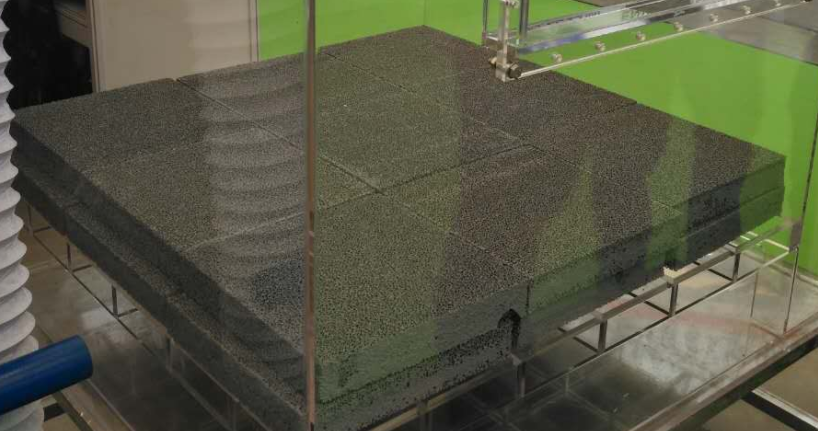From my experience, choosing the right industrial air filter seems simple. The real test is figuring out what is floating around in your workplace air. Have you noticed how dust, oil mist, and fumes get on everything, no matter what you’re doing? I think picking the best filter is more than just checking a box. There’s an important first step that I’ve seen many people skip.
Identify the Specific Contaminants
In my experience, choosing the right industrial air filter starts with one thing: knowing what’s in your air. You must identify the specific harmful particles in your workspace. Different workplaces have different pollutants, which affect your filter choice. Here are the key types of contaminants I look for:
- Solid particles: This category covers dust, pollen, fibers, and tiny metal shavings. I have also seen fragments from O-rings, filter housings, tubing, and fittings get into the air.
- Oil aerosols and vapors: These usually come from compressors, lubricants, or process emissions. I find them frequently in manufacturing plants.
- Microbial contaminants: This means bacteria, viruses, and fungi. Their presence depends on your building’s conditions and the work you do.
- Gaseous contaminants: I’m talking about chemical vapors and volatile organic compounds. These require special filtration materials or methods.
Summary Checklist for Contaminant Identification
- I suggest you sample the air at several different system points. This will give you a complete picture.
- You should use specialized equipment to get precise contaminant readings.
- Reference standards, like ISO 8573-1, to help connect your test results to your filter choice.
- Align the filter’s rating, such as 99.97% efficiency at a specific particle size, to the exact contaminants you found.
Assess Your Application and Environment
In my experience, picking the right industrial air filter starts with two things. You need to look at where you’ll use it and the environment around it.
Match the Filter to the Job
I find that every industrial space needs a specific type of air filter. Based on my experience, manufacturing lines are challenging environments. Fine particles and metal shards fill the air. To protect the space, you need multi-stage filters. These are designed to capture both large debris and tiny dust. A combination of high-performance particle filters and gas-phase cartridges was the solution to clear the air. Spray booths present another challenge. The overspray creates a thick fog, and the smell of VOCs is strong. For these areas, I recommend high-efficiency bags or cartridges. Pairing them with a thick carbon layer is the best practice. Data centers require constant airflow to keep equipment cool. I suggest using MERV 11–13 filters for them. These filters catch dust effectively without blocking the vital cooling air. For places like cleanrooms and hospitals, air purity is critical. You must use HEPA or ULPA filters, which have a MERV 17–20 rating. I find it is essential that these filters are certified. International standards and frequent real-world inspections confirm this is a strict requirement.
Meeting Standards and Compliance
You have to follow industry standards. Different industries have different rules for filtering air. ANSI/ASHRAE Standard 62.1-2022 says non-business spaces need at least a MERV 8 filter for basic protection. I recommend a MERV 11 or higher filter in areas with high PM2.5 or where fine dust is a problem. HEPA or ULPA filtration is a must-have in sensitive fields like pharmaceuticals, biotechnology, or hospitals. You should check the current EPA and OSHA guidelines. They list the safe exposure limits for your specific work.
Think About Environmental Factors
Your local environment affects your filter choice. If your facility is in a place with high outdoor pollution, like frequent PM2.5 spikes, I suggest installing MERV 11 or higher filters where fresh air comes in. If your workers or products are around chemical fumes or gases, you should use filters that absorb chemicals. Look for ones with Activated Carbon or another special material. For jobs with VOCs, oil mists, or very fine dust, you need filters made just for those specific pollutants.
Checklist: Assessing Your Application and Environment
- Figure out what work happens in each space and what pollutants are made.
- Match the filter’s MERV or HEPA rating to your safety and compliance needs.
- Check your local area for hazards like dust, fumes, or chemicals.
- Think about filter costs, system performance, and planned maintenance.
- Make sure you reference the current standards and regulations for your industry.
From my point of view, picking the right filter setup improves safety. It gives you cleaner air and helps your equipment last longer.
Get to Know Air Quality and Official Standards
From my experience, picking the right industrial air filter means you first need to understand air quality standards. Following these standards is more than just a requirement. It affects how well your filter works and ensures your workplace is safe.
Important Air Quality Standards
ANSI/ASHRAE Standard 62.1-2022:
I see this as the starting point for indoor air quality (IAQ) in U.S. industrial and commercial buildings. A Minimum MERV 8 filter is what most spaces require. If you work in a place with high particle levels like PM2.5 or lots of dust, I recommend stepping up to MERV 11 or higher. For healthcare, I know that OSHA requires MERV 13 or higher. These filters capture 89–90% of particles between 0.3–1 micron.
ISO 8573-1:
This standard is common for compressed air used around the world. I find it helpful that it defines classes based on Particle size and count, Water dew point, and Oil content. Class 1 is the strictest. It allows a max of 0.1 µm particles, ≤20,000 particles/m³, oil ≤0.01 mg/m³, and a dew point of -70°C or lower. Class 2 allows a max of 1 µm particles, ≤400,000/m³, oil ≤0.1 mg/m³, and a dew point of -40°C or lower.
Another standard, ISO 12500, gives you guidelines for testing filters and their performance ratings.
UL Safety Standards:
If you use electronic air cleaners, ESPs, or UV systems, I suggest you make sure they follow UL867. This standard focuses on electrical safety and ozone emissions. For mechanical filters, you need to follow UL507 for electrical safety.
OSHA Standards (29 CFR § 1910.134):
These set the rules for “Grade D breathing air” in respirators. The goal is to limit how many contaminants people are exposed to. I believe these rules show how important good filter performance and regular upkeep are.
My Recommended Checklist
- First, I recommend you identify which standards your facility needs to follow: ASHRAE/OSHA (US), ISO (global), or your local rules.
- Then, choose a filter that meets or goes beyond the minimum rules. Your baseline should be MERV 8, but for critical areas, I suggest MERV 13+.
- You should check that your filter devices have the right certifications, like UL or ISO. This is very important if you use UV or electronic air cleaners.
- I suggest you create and follow a written maintenance plan. You should also do regular performance testing as required by the rules and filter makers.
How I Determine the Right Industrial Filtration Efficiency
From my experience, picking the right industrial air filter means you have to match your specific needs with the correct filtration rating. I find the main standards are MERV, HEPA, and ULPA ratings. Each one is made for different levels of particle control.
My Steps to Select the Correct Filtration Efficiency
- I first identify the smallest particle size and pollution risk for your work environment. You also need to consider your compliance targets.
- I suggest you consult industry standards. For instance, you can use ASHRAE Standard 52.2 for MERV. For HEPA/ULPA needs, EN 1822 is the one to check.
- I always try to balance efficiency with energy costs. Higher-rated filters like HEPA and ULPA can increase energy bills because they create more airflow resistance. You should assess how much filtration you truly need so you don’t overspend on equipment and upkeep.
- You must also factor in maintenance. High-efficiency filters need more frequent checks and replacement. This is especially true when the air has a high level of contaminants.
In summary:
Based on my experience, choosing the right filter efficiency isn’t just about catching dust. I believe you must understand your specific contamination risks and follow industry standards. You also need to know the particle sizes you are up against. Finally, you have to manage the balance between air safety and your operational costs.
Evaluate Airflow Rate and Pressure Drop
I recommend you check both the airflow rate and pressure drop when you pick an industrial air filter. These two factors impact your system’s performance. They also affect your energy use and overall costs.
Understand Airflow Rate Requirements
Airflow rate is the volume of air moving through your system. We measure it in cubic feet per minute (CFM) or cubic meters per hour (m³/h).
Different industrial systems have different needs:
- Paint booths require 6,000–30,000 CFM.
- Dust collection systems in wood processing may need over 50,000 CFM.
- A pharmaceutical cleanroom with 20 air changes per hour (ACH) in a 5,000 ft² space needs about 20,000 CFM.
I suggest choosing a filter that meets or exceeds your needed airflow rate. If your filter is too small, it will block airflow. This makes your system less effective.
Assess Pressure Drop
Pressure drop measures the resistance a filter creates to airflow. We measure it in inches of water gauge (in wg) or Pascals (Pa).
Here are the initial pressure drops I see for common filters:
- Panel filters: 0.2–0.5 in wg
- Pleated filters: 0.3–0.7 in wg
- HEPA filters: 0.9–1.2 in wg
- Bag filters: 0.4–1.0 in wg
When the pressure drop goes up, your system’s fans work harder. For every 1 in wg jump in resistance, fan energy use can climb by up to 5%. This will raise your utility bills. Based on my experience, replace filters when the pressure drop is 1.5 to 2 times the starting value. This saves you from high energy costs and keeps your air clean.
Balancing Airflow and Pressure Drop
Your goal should be to keep your needed airflow, like 10,000 CFM. At the same time, keep the pressure drop low. I recommend ≤0.5 in wg for general industrial use.
Some jobs are more sensitive, like cleanrooms or electronics manufacturing. These may need even lower pressure drop. You might need stronger fans for HEPA or ULPA filters.
Looking at the pharmaceutical cleanroom example, they chose HEPA filters with a 1.0 in wg initial pressure drop. They also upgraded the fan. This helped them meet strict ISO standards and run the system well.
From my experience, if you watch your airflow rate and pressure drop, you get better results. Your industrial air filtration will give you consistent air quality, help control energy use, and protect your important work areas.
Choose the Appropriate Industrial Filter Type
To pick the right industrial air filter, I suggest you look at a few things. What contaminants are in your air? What are your pressure drop limits? And what efficiency do you need? You also have to meet current industry standards.
Major Filter Types and Their Uses
HEPA filters: These filters trap 99.97% of airborne particles that are 0.3 microns or larger. In my experience, they are essential for hospital clean rooms, pharma manufacturing, and labs. These places need tight control over bacteria and viruses. The typical MERV rating for them is 16–20.
MERV-Rated Filters: Every filter has a Minimum Efficiency Reporting Value (MERV). This rating shows you how well it can remove particles. I usually see MERV 8–14 filters in offices and general buildings.
Minipleat Filters: These use tightly packed pleats to hold more dust and keep pressure drop low. From my experience, they are a top choice for cleanrooms and electronics plants that need consistent, high-efficiency filtering.
Bag Filters: Bag filters can hold a large amount of dust. I’d suggest them for industrial exhaust systems or for any facility that deals with bulky and heavy dust loads.
Washable Filters: If you want a filter you can reuse, I like washable filters. They are a practical choice for schools, commercial kitchens, and general offices. In a kitchen, a washable grease filter catches airborne oils and helps lower fire risks.
Carbon & Media Tray Filters: These filters use layers of carbon or chemical pellets. They capture volatile organic compounds (VOCs) and get rid of odors. You can find them in chemical labs, print shops, and sites near pollution sources.
UV Filters: UV filters use ultraviolet light to kill bacteria, mold, and viruses. I see them often in healthcare areas and HVAC systems, particularly in damp spaces with a high risk of biological germs.
Based on my experience, you should always check your filter choice against local air quality standards. You also need to confirm it is compatible with your equipment. I strongly recommend reading the manufacturer’s spec sheets and the ISO/ASHRAE/EN guidelines. This will help you avoid mismatches and performance issues.
How I Verify Equipment Compatibility
Making sure your air filter fits your equipment is a top priority. In my experience, it’s key for performance, safety, and how long the system lasts. Here’s my method:
Confirm Physical Fit and Installation
First, I check that the filter’s size, shape, and connections match the equipment. A filter that doesn’t fit well can cause leaks or let air bypass it completely. I’ve found that many suppliers, like AFE, provide replacement filters made to fit the original gear. They offer different sizes for various brands.
Analyze Total Cost of Ownership
When I choose an industrial air filter, I look at the total cost of ownership (TCO), not just the sticker price. Here is my method for breaking down TCO to help you make smarter, long-term decisions.
Core Components of Total Cost of Ownership
Energy costs: From my experience, energy is the biggest expense. It can make up 70%–81% of a filter’s lifetime cost. Why? A filter’s pressure drop forces your fans to work harder. This increases your energy bills. For perspective, over 50% of a commercial building’s energy bill can come from the HVAC system. A high-resistance filter just makes that cost go up.
Filter purchase costs: I find that many buyers focus too much on the upfront price. The truth is, a filter’s purchase price is often less than 10% of the TCO. For large systems like dust collectors, I’ve seen operational and disposal costs reach almost 90% of the total.
Labor and maintenance: Don’t forget this part. Changing filters frequently and doing inspections requires more technician hours. I suggest using long-life filters because they reduce this work. This saves you money on labor and handling expenses.
Disposal costs: Disposing of used filters costs money. This is a big factor for filters that handle hazardous materials, which can create high costs for waste hauling and meeting environmental rules.
Indirect Cost Factors
I always remind my clients that TCO can include less obvious costs. Worker productivity can improve or decline depending on the air quality. Good filtration protects your HVAC ductwork, coils, and other system parts. This reduces future maintenance bills. I believe cleaner air leads to employees having fewer sick days and better focus at work.
Case in point: For dust collector setups, my experience shows that 90% of the total cost comes from energy, maintenance, and disposal—not the initial filter price.
My Practical Recommendation
Bottom Line: My advice is to never choose industrial air filters based just on price. Analyzing the true TCO—which includes energy, replacement, labor, and disposal—will result in cleaner air, lower costs, and more dependable operations.
Consult with Air Quality Experts or Manufacturers
I recommend talking with air quality experts or industrial air filter makers. They have specialized knowledge and can create filter solutions just for you. These professionals will analyze your facility’s needs and check your emissions. From there, they help you find the best air filter technology for your workspace.
Why Consult Experts or Manufacturers?
From my experience, experts will visit your site to perform a survey. They use modern tools to measure air quality and list all extraction points. After this, they create a detailed report with their recommendations. For better precision, they might use drawings or even computer models like SolidWorks or CFD simulations.
Custom Filtration Solutions: Industrial Filter Manufacturers and consultants use your data to engineer a filter that fits your facility. They don’t just offer you a generic product.
Regulatory and Standards Compliance: Your industrial air quality needs to meet strict rules, like ISO and National Fire Protection Association guidelines. I suggest using an expert to help you pick filters with the correct Minimum Efficiency Reporting Value (MERV) rating.
Key Benefits of Expert Consultation
- They use advanced design tools like 3D modeling and airflow simulation.
- You can be sure you are following regulations and OEM standards.
- The buying and approval process is clear and well-documented.
- You get filter recommendations made for your facility, process, and air quality goals.
- They provide ongoing support to keep your filter performing at its best.
Working with air quality experts and manufacturers helps you get the right filter from the start. This brings lasting improvements in productivity, compliance, and the safety of your workers.
summary
Based on my experience, choosing the right industrial air filter is a huge decision. I’ve learned it’s much more than just buying a piece of equipment. It’s really about protecting your team and your whole operation. I believe every part of the process counts. This starts with figuring out what contaminants are in your air and goes all the way to understanding the total costs involved. When you fully assess your needs and team up with the right industrial filters suppliers, you do more than just clean the air. You build a safer, more effective workplace that helps everyone. I can tell you, this investment will provide returns in ways you might not even see coming.







